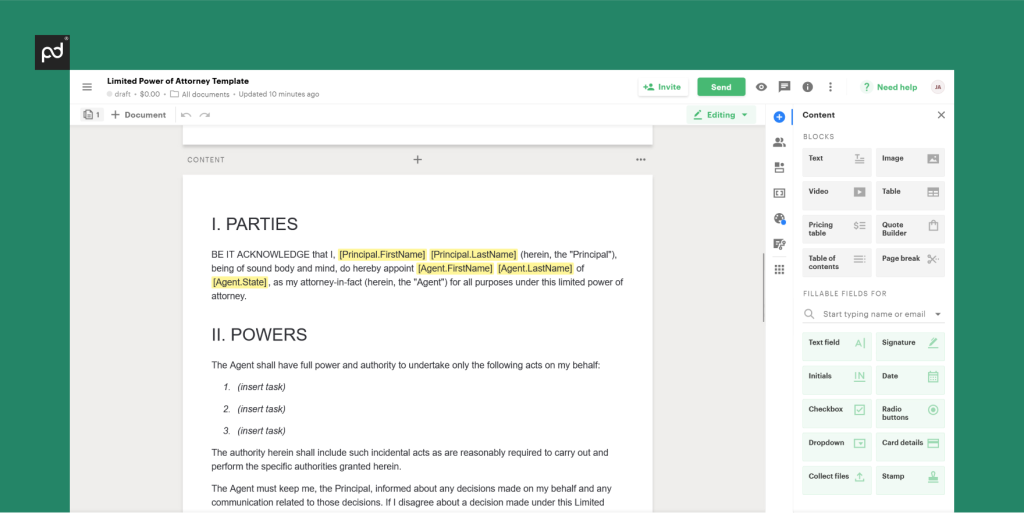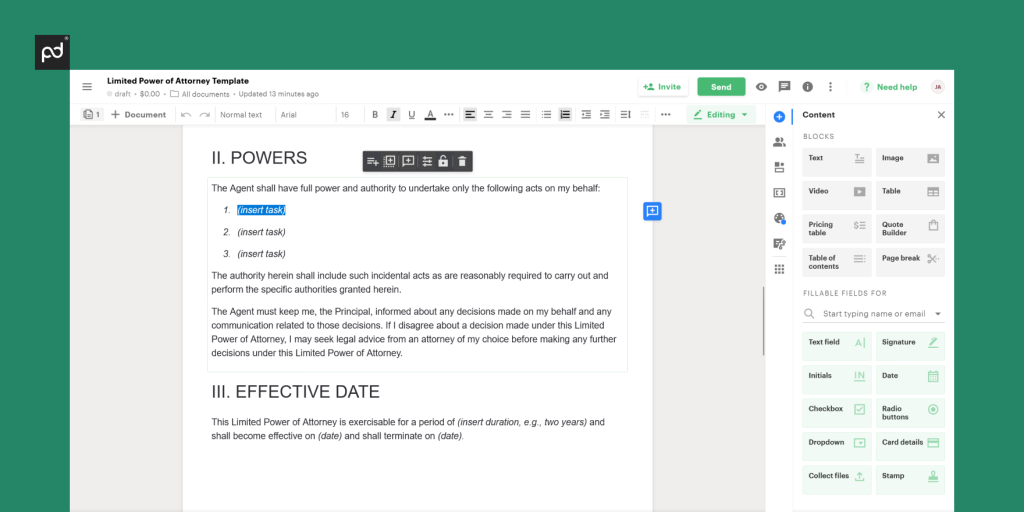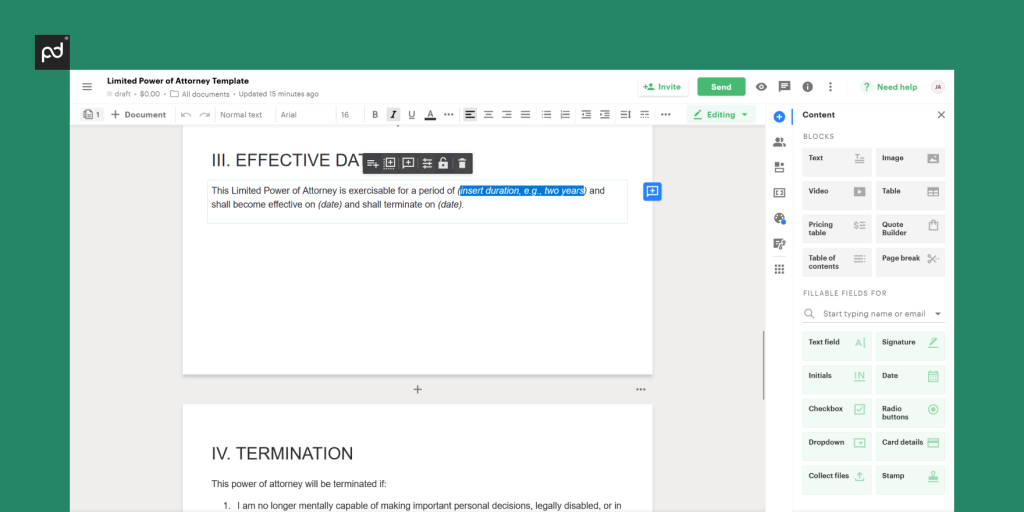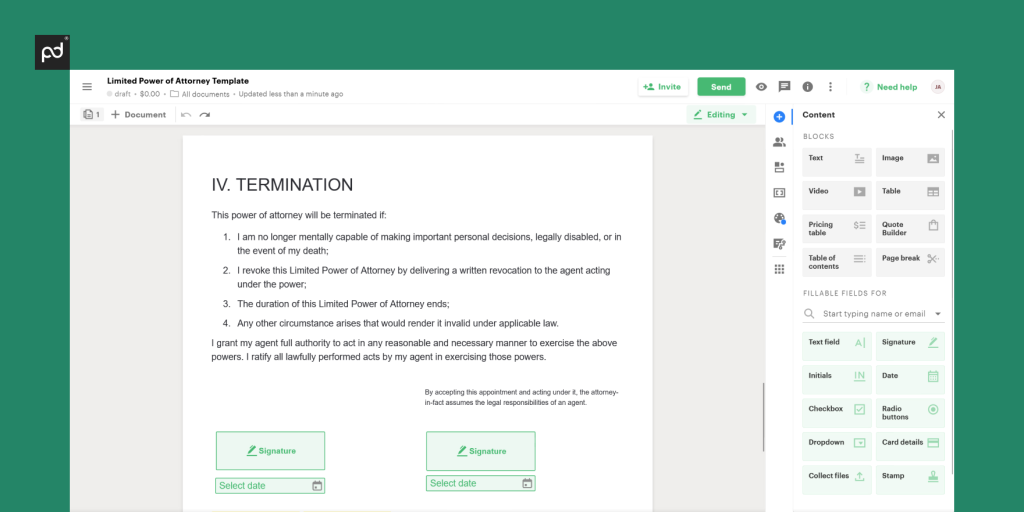A power of attorney is a useful legal tool in many situations, helping people ensure that their affairs are managed appropriately even if they’re unable to deal with these themselves.
This blog will focus specifically on a limited power of attorney, outlining the features and benefits of this type of arrangement.
It will then provide a step-by-step guide on how to use PandaDoc’s limited power of attorney template.
Key takeaways:
- A limited power of attorney allows you to delegate powers with respect to specific aspects of your affairs for a defined timescale.
- There are different types of power of attorney (e.g. general, limited, durable, and non-durable).
- Using a template (e.g. PandaDoc’s) is a cheap and convenient way to set up a limited power of attorney.
What is a limited power of attorney?
A power of attorney is a legal document granting another person authority to act on your behalf.
It allows you (the ‘principal’) to assign authority for personal matters to someone else (the ‘agent’).
There are many types of power of attorney, each suitable for covering different scenarios. It’s important to choose the right one for your purpose.
So, what is a limited power of attorney?
Imagine that, due to a future change in circumstances, you’ll be unavailable to make or act on important decisions relating to your personal affairs — for example, your health, finances, or family arrangements.
Perhaps one of these scenarios might apply:
- You’re going away for a spell of time (on vacation or with work).
- You’re facing health difficulties and need to go into hospital for an extended period (but expect to be out and active in the future).
- There’s a particular aspect of your affairs (e.g. your share portfolio) that you’d prefer an expert to deal with (for instance, a stockbroker).
In these scenarios, a limited power of attorney can ensure important personal matters are looked after without your involvement.
This allows your agent to act on your behalf according to the particular terms you specify.
Limits are placed on the agent’s powers (thus, ‘limited power of attorney’).
What might these limited powers be? Particular considerations will be listed in the document, which will typically relate to the following.
- A limited timeframe. The power of attorney might be limited to particular specified dates and is invalid outside that period.
- Limited scope. The power of attorney might only be assigned for particular aspects of the principal’s affairs. For example, a stockbroker might be assigned power of attorney for the principal’s investments and nothing else.
- Limited application. The power of attorney might be limited to a specific transaction, event, or document. For example, an agent may be authorized to sign a particular real-estate contract if the principal is unavailable to do so.
Compare a limited POA to a general power of attorney. With the latter, you grant the agent all the rights you would have over your own affairs.
The benefits of a limited power of attorney form
Any type of power of attorney is a powerful legal document.
It can allow agents to make financial transactions, buy or sell assets (e.g. property and shares), make medical decisions on behalf of the principal, and much more.
This can make it a very useful tool when used appropriately i.e. to cover a specific timeframe, scope, or application.
For example, if you’re going to be out of contact for a while and want to grant a trusted agent time-limited permission to take care of certain personal matters.
A general power of attorney is open-ended and global in its scope.
In some scenarios, this will be appropriate — for example, if the principal is going to be unable to manage their affairs at all going forward, a more open remit might be suitable.
But most scenarios don’t require such an expansive delegation of power.
A limited power of attorney allows you to tailor a targeted power of attorney arrangement, fulfilling your requirements and nothing more.
It allows you to be very specific about what you’re allowing the principal to do on your behalf.
But you still need to get it right — this is a legal document, after all.
To create a robust limited power of attorney, it’s a good idea to use a form that covers all the necessary details, thus ensuring you can safely access the benefits of such an arrangement.
True, you could use one of the many form builder apps available to design your own power of attorney document — but why reinvent the wheel?
How to fill out a limited power of attorney form
Having made the decision that a limited power of attorney is right for your needs, you must decide:
The scope and timescale of the powers you’re assigning. Be very specific!
Who’ll be your agent?
The best choice will vary depending on the scope.
For example, for financial matters, it may be appropriate to select a professional (e.g. a stockbroker or solicitor), but for more personal matters, a trusted family member or friend would be better. Obviously, discuss this with them and make sure they’re happy to be your agent.
Next, choose a limited power of attorney template. Using a template ensures you capture all the required details in the right way.
Some territories may have different rules and requirements, so check carefully, depending on your jurisdiction.
PandaDoc’s limited power of attorney template can guide you through this process. It involves the following steps.
Part 1: Specify who is the principal (you) and who is the agent (who will act on your behalf). It’s crucial to choose someone who you trust has the knowledge, skills, and integrity to best represent your interests.

Part 2: Describe the powers you (the principal) are assigning to your agent. Be as specific as possible. There’s space for three acts to be described, but more can be added to the template if required.

Part 3: Define the timescale i.e. when will the power of attorney be effective? This means specifying a start and end date and duration.

Part 4: Include any termination details. The template suggests some to incorporate into your document. However, there may be additional conditions required for your particular circumstances.

Your power of attorney document needs to be signed and dated by the principal and agent. Consider having your document notarized too.
This means getting an independent ‘notary witness’ to observe the signing.
With PandaDoc, you can easily manage your signatures online thanks to our secure and convenient electronic signature functionality.
Durable limited power of attorney vs. non-durable
Remember, there are different types of power of attorney to suit different requirements.
For example, we’ve already seen the difference between a general power of attorney (which assigns the broadest sweep of powers) and a limited one (which is more targeted).
A power of attorney document can also be either ‘durable’ or ‘non-durable’. Let’s consider what this means.
A durable power of attorney is one that remains in effect even if you become incapacitated (e.g. if you fall into a coma).
A non-durable power of attorney, on the other hand, would end in this scenario.
Each is suitable for different situations.
Durable documents may be useful for longer-term estate planning, whereas non-durable ones facilitate shorter-term, defined cover of particular aspects of your affairs.
Take advantage of PandaDoc’s limited power of attorney template
A limited power of attorney document is a useful tool if you need particular affairs to be looked after by someone else.
Although many people like to work with a professional when drafting legal documents, PandaDoc’s templates make it possible to do this without paying a large legal fee.
Each of them is carefully crafted to guide you through the process and capture any details you need.
Contact us today for more information.
Frequently asked questions
-
Work through these steps:
- Determine the scope of the powers you wish to delegate
- Choose an agent
- Ensure you understand local laws and requirements
- Select a template (such as PandaDoc’s)
- Complete the template and get it signed by yourself and your agent
- Ideally, get it notarized
- Ensure all parties have a copy.
-
The start and end date should be specified in the document. Other conditions can also be added to the template to enable you to end the limited power of attorney under particular circumstances (even when it’s live and in-date).
A power of attorney document ends upon the death of the principal. Whether or not the document continues if the principal becomes incapacitated depends on whether it’s durable or not.
-
To revoke a limited power of attorney, you need to complete a revocation of power of attorney form. PandaDoc provides a template for this.
The principal can revoke a power of attorney document at any time and for any reason. The agent doesn’t need to agree with this decision.
-
A general power of attorney gives the broadest sweep of powers to your agent. A limited power of attorney, on the other hand, can be limited in timescale, scope, and application. This means you can be very precise to ensure the power of attorney meets your needs — and nothing more.
Disclaimer
PandaDoc is not a law firm, or a substitute for an attorney or law firm. This page is not intended to and does not provide legal advice. Should you have legal questions on the validity of e-signatures or digital signatures and the enforceability thereof, please consult with an attorney or law firm. Use of PandaDocs services are governed by our Terms of Use and Privacy Policy.


